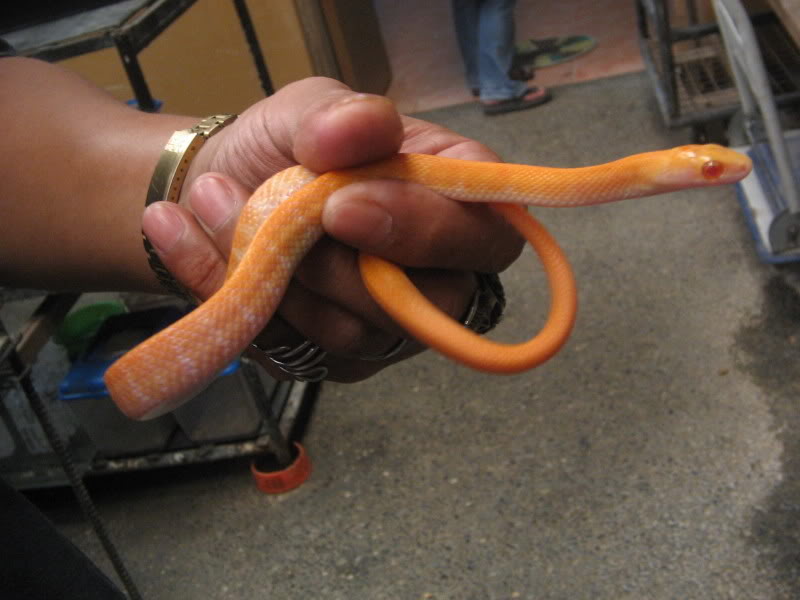HERPETOLIGICA PILIPINAS
First of Its Kind: A wild-born albino Luzon red-tailed ratsnake, Coelognathus erythrurus manillensis, brought to light from San Mateo, Rizal Province, Philippines.
Albinism is a type of recessive genetic trait incapable of producing melanin or black pigments. The red, orange-red or pink eyes and the translucent pink or orange skin are common characteristics of a typical albino or amelanistic animal, and the degree of accentuation is variable. Although a number of albino animals in the past were mass–produced to meet the demands of the pet market, wild species having such kind of genetic abnormality tend to be very, very rare. Next to the popular pet shop albino rabbit, the albino laboratory mouse (Mus musculus), because of its white, hygienic-looking characteristics was probably the first mammalian species ever to have had been mass-produced --- a necessity for medical and other related laboratory research work ---. Unaccountable numbers of albino fishes, birds, reptiles and amphibians have also been mass-produced to supply the pet market all over the world.
Albino animals native to the Philippines are remarkably rare. In mammals, the domesticated albino water buffalo or carabao (Bubalus bubalis) occurs in some rural areas in Luzon, but is infrequently encountered. The albino Philippine long-tailed macaque (Macaca fascicularis) is also rare.
In reptiles, rumors of an allegedly discovered clutch of wild albino water monitor hatchlings (Varanus salvator ssp.) in Aklan Province in the Visayas (exact locality unknown) sometime in 2002 was said to be untrue. According to the late Eutiqiuo Igos of Kalibo, Aklan, Panay Island, a white water monitor with red eyes claimed to have been traversing the mountain trails between the provinces of Aklan and Iloilo was occasionally sighted in the late 1980’s. Local folks believe that the red-eyed white monitor was an engkantada or a fairy who transform herself into an animal, and a wicked curse of sickness and poverty would befall upon whoever attempts to harm or capture the white lizard.
In Philippine cobras, documented facts on extant populations of albino Naja philippinensis, albino Naja samarensis, and albino Naja miolepis have never been published since their description in the early 1900’s. Some local folks in rural areas of Luzon, Leyte, and Mindanao have claimed to encounter “white” cobras in their respective areas. And not until a specimen (dead or alive) is officially presented to the local herpetocultural community, allegations of albino Philippine cobras occurring in those said areas should be considered invalid.
The only cobra species in the world often seen with amelanistic trait is probably the Asiatic monocled cobra (Naja kaouthia). These albino monocled cobras are being bred exclusively for zoological institutions in western countries. Philippine endemics of albino colubrids also have never been documented until the year 2006.
On August 15, 2006, the first amelanistic Luzon red-tailed ratsnake (Coelognathus erythrurus manillensis), a juvenile, was brought to light. Its capturer, an anonymous resident of Barangay Guitnang Bayan, San Mateo in Rizal Province said that the translucent-skinned, orange-colored snake with red eyes slithered into his house shortly after a heavy downpour to seek refuge. The snake was then brought to the Avilon Montalban Zoological Park in Rodriguez, Rizal, a few kilometers away from the discovery site.
The world’s first wild-born albino Coelognathus erythrurus manillensis is now in the care of the Department of Herpetology and Arachnology at the Avilon Montalban Zoological Park, under the supervision of its Curator, Matthew D. Yuyek. Captive husbandry and veterinary supervision are being given and a well-trained keeper is assigned to look after feeding and maintenance work of this rare variety of C. e. manilliensis.
To a few, the albino animal is still being considered as atypical because the morphological characteristic compared to their normal-phased conspecifics does not show any dissimilarity, except the coloration; many still consider them as being weird creatures. But still, albino animals nonetheless are creatures of the Earth with distinctive and eye-catching characteristics that deserve the right to live and be appreciated.
